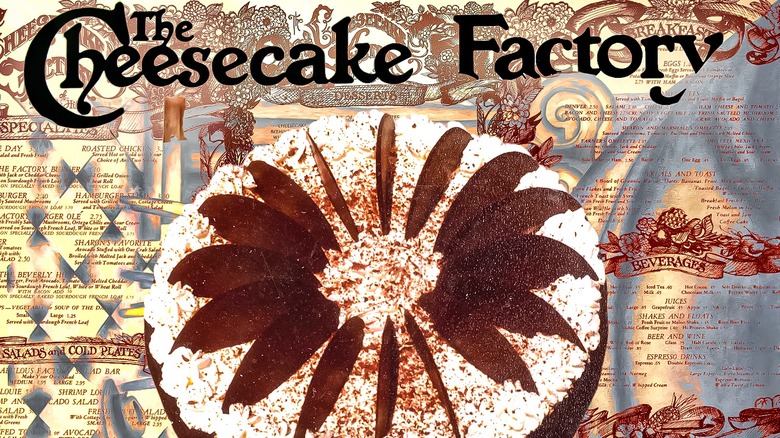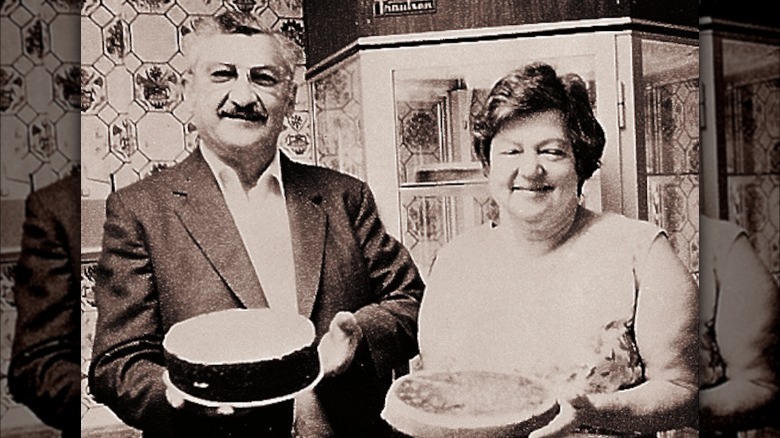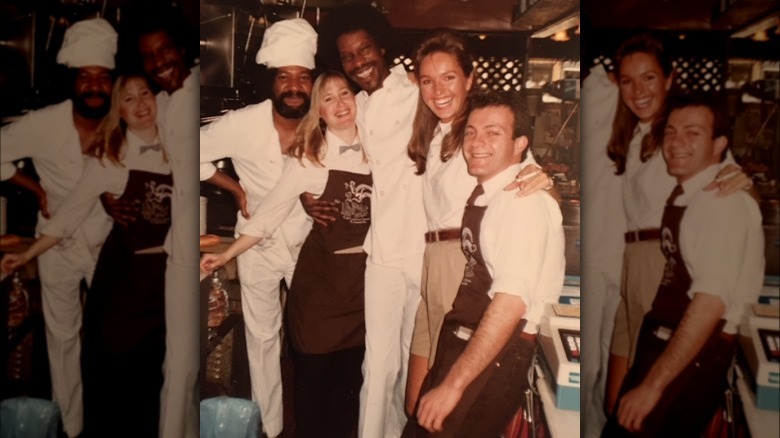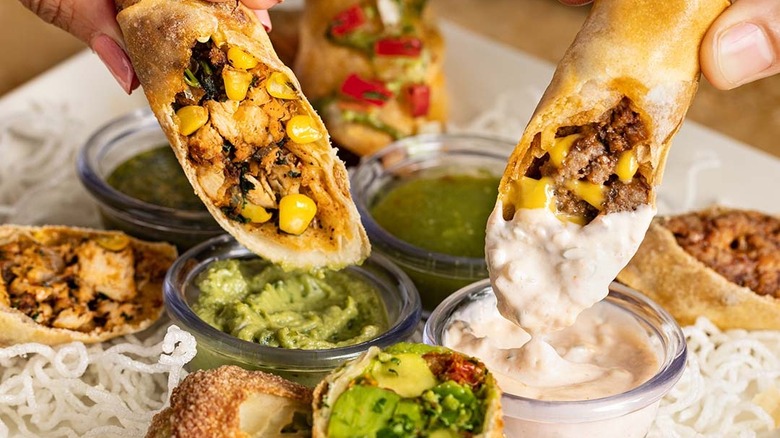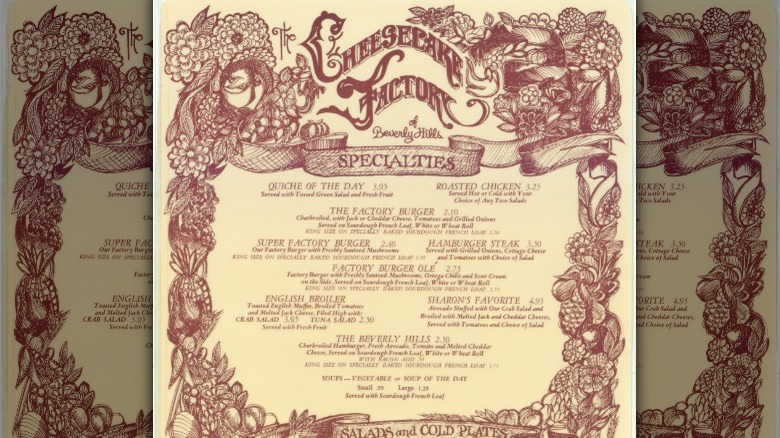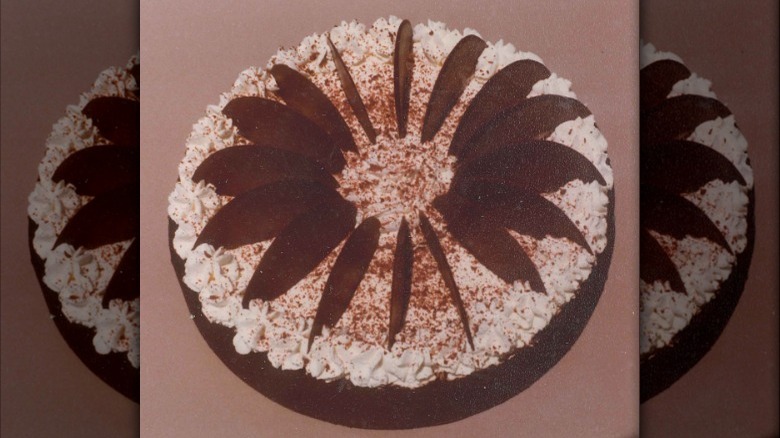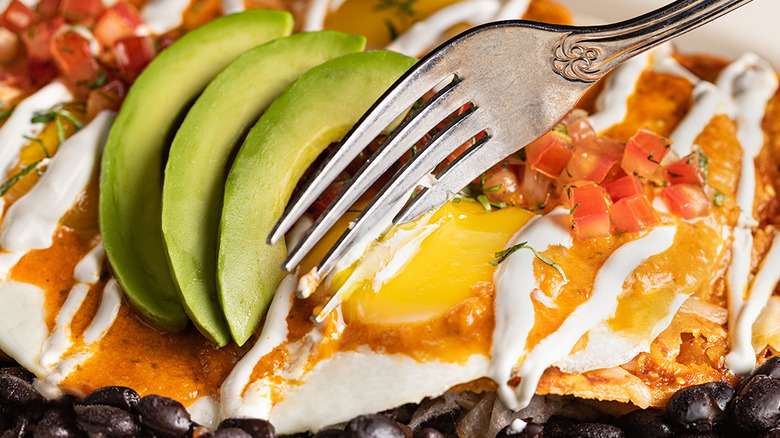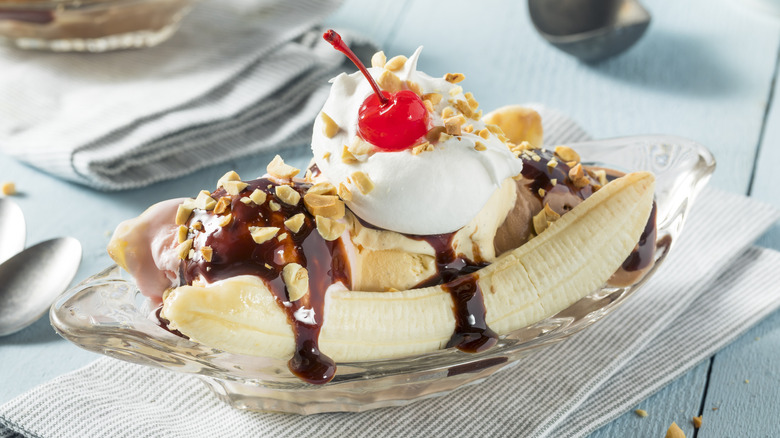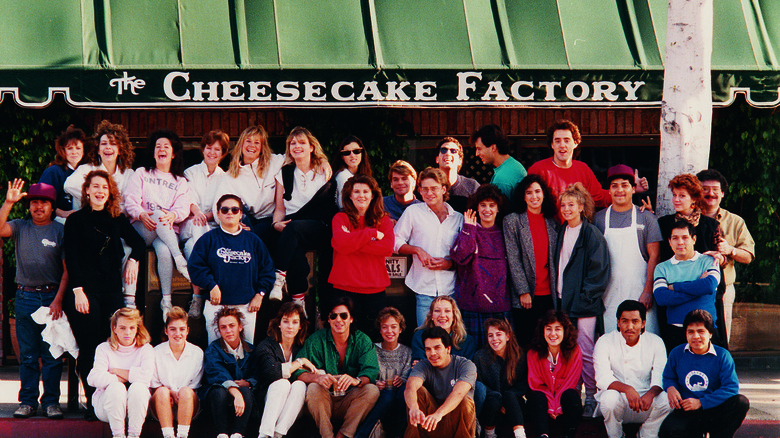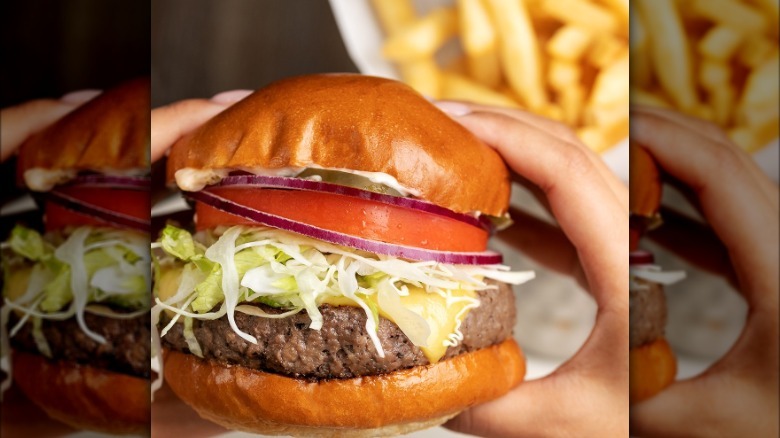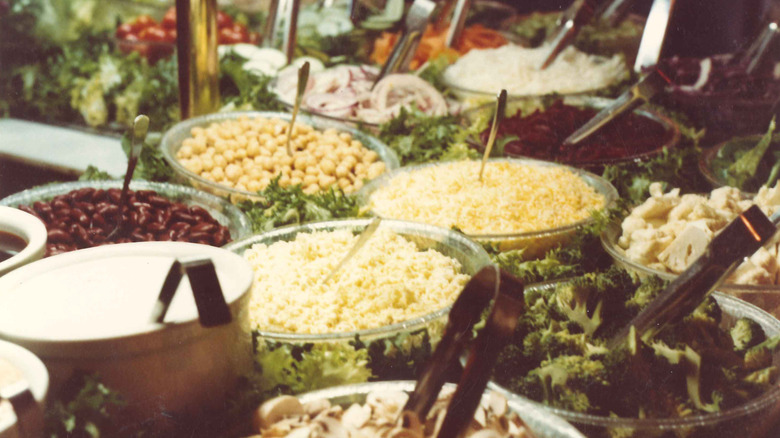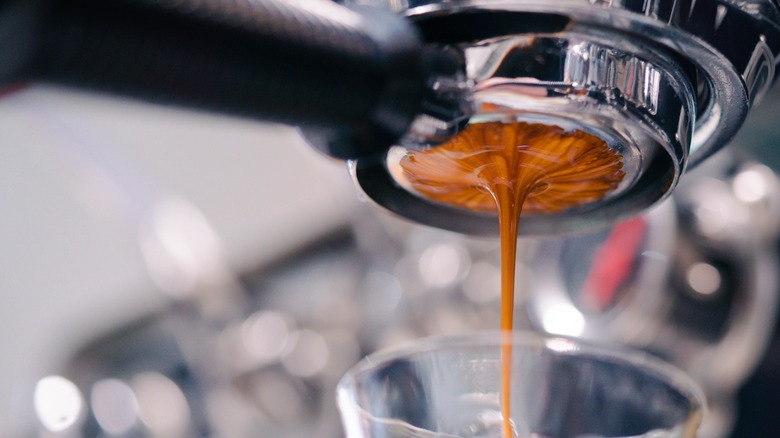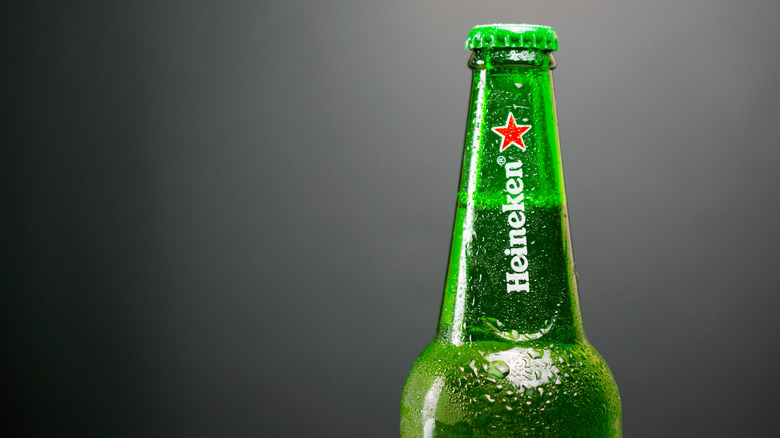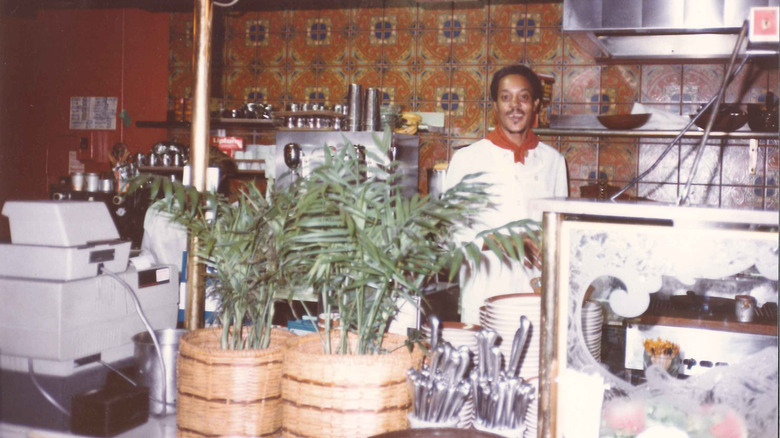Sardine Sandwiches And Wyoming Humdingers: A Look At The Original Cheesecake Factory Menu - Exclusive
The Cheesecake Factory is celebrating its 45th year in business in 2023. While the chain's famous cheesecake has roots that go back even further, the first full-service Cheesecake Factory restaurant opened its doors in Beverly Hills in 1978. The establishment's founder, David Overton, was intimidated at first. Fortunately, his nerves didn't sabotage his new venture. According to an exclusive Tasting Table interview with Cheesecake Factory executives, opening day was worrying for Overton. "To avoid the lunch rush, he put a small handwritten sign in the window that read, 'Open at 2 o'clock.' Somehow, the restaurant was an immediate success! Without any advertising, a line started forming in front of the building at 1:30 p.m. They opened the door at 2:00 p.m. and the restaurant was full within 10 minutes."
As the chain has grown from a single restaurant to an international chain with over 200 locations, its menu has grown and changed, too. We're taking a look at what the food at the very first Cheesecake Factory was like. Our interview with the company's executives combined with archival photos of the original menu has helped us paint a complete picture of the Beverly Hills restaurant that started it all.
The cheesecake came before everything else
The Cheesecake Factory may be famous for serving every type of food under the sun these days, but the origin of the business is in the name: classic cheesecake. Evelyn Overton adapted the recipe that has been the foundation of The Cheesecake Factory's success from a newspaper. She added a couple of special touches to the formula and quickly became famous in her local Detroit community for her amazing cheesecake, making it for social functions and eventually opening a small bakery.
While the Overtons lived in Detroit, the cheesecake business was always a side hustle. That all changed when Evelyn and Oscar Overton's son, David, moved to Los Angeles. His parents followed him and opened another cheesecake business, this time on a larger scale. This version of The Cheesecake Factory delivered wholesale desserts to restaurants across LA. However, the business was still limited in scope because restaurants didn't want to buy more than a few types of dessert from the Overtons. As the executives told us, "While their business found modest success, Oscar would often hear, 'no one needs more than one flavor of cheesecake' as he attempted to sell Evelyn's selection of cakes to restaurants, and sometimes restaurant owners would switch to an inferior product to save a nickel a slice." Because of this obstacle, David Overton decided he wanted to start his own restaurant with a menu built around his mom's desserts, and the Cheesecake Factory as we know it was born.
The first menu had a Detroit flair
David Overton didn't have restaurant experience, so he came up with a menu of foods that were familiar to him and that he could execute well. Since he grew up in Detroit, the initial Cheesecake Factory menu included a few dishes that he remembered from his Motor City upbringing. "The original Beverly Hills menu had a Wyoming Humdinger similar to Darby's in Detroit, and the Adam's Favorite hot fudge cream puff was similar to a cream puff David grew up eating at Sanders in Detroit," the executives told Tasting Table.
So what is a Wyoming Humdinger, and why is it called that if it's apparently a Detroit specialty? Per the 1978 Beverly Hills Cheesecake Factory menu, it looks like a Reuben variation with corned beef, pastrami, or roast beef topped with cole slaw, Swiss cheese, and Russian dressing. Sadly, the origins of its confusing name seem to have been lost to time, as has the restaurant that invented it, Darby's Delicatessen. It was a massive Jewish deli in Detroit that served as a hub for the community, cranking out sandwiches, soup, pastries, and more until it burned down in 1968. Its legacy has receded even more into the past now, as the Humdinger isn't on The Cheesecake Factory's present-day menu.
There were no fries (or any fried food) originally
It's hard to imagine the Cheesecake Factory today without fried food. From french fries to egg rolls to chicken strips, a good chunk of the menu would be impossible to pull off without a deep fryer. Shockingly, the first Cheesecake Factory location in Beverly Hills didn't have any fried food on the menu when it opened in 1978.
The lack of fried options didn't have anything to do with health concerns. Rather, it was a byproduct of David Overton's inexperience with the restaurant business. According to Cheesecake Factory executives, "He didn't know how to use a deep fryer, so the restaurant didn't initially offer french fries." That's right — none of the burgers or sandwiches on the first Cheesecake Factory menu came with fries. In fact, they didn't come with anything on the side at all.
That's not to say that you couldn't get any sides, but they tended to be light and simple things like a cup of soup or one of the restaurant's many salads. If you wanted to load up on fat, you had to wait until the cheesecake came for dessert.
The 1978 menu was shorter than the current one
The Cheesecake Factory's epic book-length menu is famous. It's impressive how the restaurant is able to execute hundreds of dishes at a high level. The first location's menu wasn't quite so voluminous, although it wasn't particularly short either, per the executives. "The original Beverly Hills menu was much smaller than the menu is today (about 60 items versus 250+ today)."
The menu expanded slowly as the decades passed. "Over time, as the restaurant continued to grow in popularity, David was inspired to add new things to the menu. As he says, he 'didn't want to be left behind' if there were items that his guests wanted that weren't already on the menu."
The last big menu expansion happened in 2011 when the chain added the SkinnyLicious section of diet-conscious items. That bumped the total number of dishes up from around 200 to the current 250+ total. The menu still gets changed twice a year to keep it fresh, just as it has been since 1978. These days, some items get taken away when new things are added, so the total length of the menu remains stable.
The dessert menu was always massive
One part of the menu that has always been enormous is the dessert section, which was, after all, the reason for the restaurant's existence. Per the company, "[David Overton's] only goal was to help build a reputation for his mom's cheesecakes so that other restaurants would take note and want to buy her cakes." The first Cheesecake Factory was essentially a test to prove David's hypothesis that an extensive dessert menu could make a restaurant successful. Needless to say, it worked, as the Beverly Hills location was a success from the moment it opened.
The original Cheesecake Factory menu included 30 flavors of cheesecake (four of which were seasonal). The restaurant still carries over 30 flavors, but most of the original ones are no longer served. The exceptions are Evelyn's Original and Fresh Strawberry, which have been best-sellers for the restaurant's entire history. We're curious what bygone varieties like Pink Squirrel, Rocky Road, and Praline would have tasted like.
The cheesecakes were only a fraction of the sweets selection at the original Cheesecake Factory. You could also order zucchini cake, Napoleons, Black Forest cake, and more. That's not to mention the pies and pastries like strudels and cream puffs. There was no chance your sweet tooth would go unsatisfied.
The breakfast options were extensive
The Cheesecake Factory serves breakfast food and is open for brunch on the weekends, but the breakfast selections make up a relatively small fraction of the chain's menu these days. In 1978, breakfast food was a pretty large chunk of the total menu. Back then, just like now, you could order breakfast all day.
Today's breakfast and brunch options are mostly big, heavy platters like chilaquiles or a Monte Cristo sandwich that will fill you up for the whole day. In contrast, the 1978 menu contained many lighter morning options. You could start the day right with a fiber-rich dish of granola, fruit, and nuts with milk, or even just order a simple bowl of cornflakes. Eating a small pastry like a Danish or a slice of coffee cake was also an option. You can actually imagine having a productive day after a breakfast like that. All we can do after polishing off a huge breakfast from The Cheesecake Factory nowadays is take a digestive nap.
One whole menu section was devoted to ice cream
One section of the menu that has actually shrunk over time is the Ice Cream Delights. As of this article's publishing date, that section has only three items: the hot fudge sundae, Godiva chocolate brownie sundae, and bowl of vanilla ice cream.
That's dwarfed by the original location's ice cream menu, which contained 13 selections. Judging by the menu, the first Cheesecake Factory was a full-on ice cream parlor in addition to a restaurant. There were four flavors of sundaes as well as a classic banana split. For a caffeine jolt, you could order something called an Espresso Ice Cream Surprise (we assume it was something like an affogato). If you wanted to combine baked goods with ice cream, you could choose between an ice cream-filled cream puff or waffles or fudge cake topped with ice cream. Renee's Special, which consisted of a broiled pineapple slice topped with ice cream, cinnamon, and brown sugar, sounds like it was divine. As if that weren't enough frozen desserts, there was also a separate section of shakes and floats that included milkshakes, protein shakes, a root beer float, and fruit shakes. That sounds like a lot of potential brain freeze.
Some menu items haven't stood the test of time
Consumers' tastes change, and The Cheesecake Factory changes with them. Many things on the restaurant's first menu are no longer available. One of the first things to go was Oscar's Special, named after David Overton's father. As the executives put it, "Oscar loved sardines, [but] many other people didn't — so Oscar's Special sardine sandwich didn't last very long on the menu." We can't really imagine the combo of sardines, cream cheese, and onions on a bagel doing any better in 2023 than it did in 1978.
While Oscar's Special flopped out of the gate, some dishes that were early hits for the restaurant have also been phased out over time. Quiche Lorraine, stuffed avocados and tomatoes, and the Wyoming Humdinger were all very popular when the restaurant opened but have since been deleted from the menu. We wish we could see what the stuffed avocados looked like; according to the company, "They were served on big leaves of lettuce in huge white plastic bowls shaped like seashells and had a really dramatic presentation."
Looking at the 1978 Cheesecake Factory menu is like stepping back into a bygone era of American dining. When was the last time anyone saw Crab Louie on a restaurant menu? What about carrot-raisin salad? The restaurant has certainly evolved with the times, and that's probably a good thing.
Burgers and omelets have been around since the beginning
Despite all of the menu churn, some dishes have stayed on the menu since the '70s. The cheesecake has always been a mainstay, of course, and all-day omelettes and burgers have stuck around as well. The Factory Burger with cheese, tomatoes, and grilled onions was an immediate hit, as were the omelettes.
Of course, some things have changed. The hamburgers were not called Glamburgers like they are now. There were different topping options, too. The Factory Burger Olé seems like it was an attempt at south-of-the-border flair with mushrooms, canned chiles, and sour cream. The Beverly Hills burger embodied the spirit of California with avocado. If you were extra-hungry, you could super-size your burger and have it served on a loaf of sourdough French bread. Most of the '70s burgers sound pretty good, but we're glad the bunless Hamburger Steak with cottage cheese has been relegated to the dustbin of history.
There was a salad bar
Today's Cheesecake Factory has a plethora of salad offerings, but you won't find a self-serve salad bar. The original Beverly Hills location proudly advertised its Fabulous Factory Salad Bar. Given the tastes of the era, it's not surprising that The Cheesecake Factory had a salad bar when it launched in 1978. The chain Lettuce Entertain You sparked a salad bar fad in the 1970s, and by 1979, the trend was mainstream enough that it had even spread to fast food restaurants. People who grew up in the peak salad bar era will probably get a fuzzy sense of nostalgia looking at the above photo of the Beverly Hills Cheesecake Factory's original salad bar with its bowls of shredded beets, raw broccoli, chickpeas, and more, all decorated with ornamental leaves of lettuce.
If you didn't feel like building your own salad, there were a few preset options as well, including a shrimp and avocado salad and the Factory Chef's Salad with meat, cheese, and greens. You couldn't find anything as adventurous as the Chinese Chicken Salad or Santa Fe Salad back in 1978, though.
The first Cheesecake Factory had many cafe offerings
We don't think anyone stops at The Cheesecake Factory for their morning coffee, but you can get lattes, cappuccinos, and other cafe drinks from the chain. This was true from the start, and the espresso drinks were an important and popular part of the original menu.
The selection was nowhere near as expansive as at a modern coffee shop — you could get espresso with or without a lemon twist, a cappuccino with nutmeg, a cafe mocha, or a latte. Still, this would have been rather cutting-edge in 1978. Starbucks was founded in 1971 but didn't transition to being an Italian-style cafe until the 1980s. Espresso wasn't a part of mainstream American culture until the 1990s. Had circumstances been different, The Cheesecake Factory might have become a pioneer in American coffee history instead of a groundbreaking chain restaurant. It must have felt special for the restaurant's customers to be able to order fancy European-style coffee drinks to wash down Evelyn's cheesecake in the late '70s.
Alcoholic options were limited
The original Cheesecake Factory location served only wine and beer. Wine lovers could choose between the house white, red, or rose, or make things fun with sangria or a wine cooler. Hop-heads were limited to an unnamed draft beer, Coors, or the "fancy" option, Heineken, which came in light and dark varieties and was the most expensive single serving of alcohol on the menu at $1.25. Alcoholic beverages clearly weren't the focus when the restaurant opened.
In comparison, the modern Cheesecake Factory menu is a bonanza of cocktail choices. Booze probably isn't the main attraction for most patrons, but you could still order a cocktail every day for three straight weeks without having to drink the same thing twice. As with the menu as a whole, the alcoholic offerings have followed the chain's "more-is-more" aesthetic, with a wide variety of multicolored drinks in numerous sugary flavors. You can still order sangria, so there's one point of continuity between the chain's modern bar and its original alcohol menu.
Prices have gone up since the '70s
Inflation is a hot topic these days, and it's no surprise that The Cheesecake Factory's prices are higher now than they were 45 years ago. Even adjusting for inflation, the restaurant is a little more expensive now than it used to be. The photos of the first location show a restaurant that looks a little more humble than the sumptuous palace of food you'll encounter if you step inside any modern Cheesecake Factory. It seems as though the prices have risen with the level of the décor.
It's a little bit challenging to do direct price comparisons since so much of the menu is different, but there are a few constants we can use as examples. In 1978, a Factory Burger went for $2.10, which is $9.72 in 2023 dollars. The Classic Burger costs $17.95 today (though that includes fries or a salad). The Farmer's Omelette from the original menu cost the equivalent of $13.66, while the loaded omelettes on the modern menu run $16.50.
Not everything was super cheap in 1978. The Quiche of the Day with salad cost $3.95, or almost $19 in modern money.
